I guess everyone will have to deal with the questionable ads.
But, heh, bills gotta get paid!

Too bad I can’t be there…
http://www.zusaar.com/event/564008
Sorry guys, still in Hong Kong, I won’t be in Japan until May/June.
(Note this is a guest post from Tenox)
Despite having an unofficial and experimental support for some time now I was not able to install Solaris 9 on VMware Workstation. I have recently upgraded to Workstation 9.0 and Lorenzo Gatti send me a link to complete Solaris 9 x86 u5 media kit so I had an excuse to retry.
After several tries I have determined that the easiest route is to boot and install from cd1 instead of the install disk. Also make sure to select VESA driver instead of standard VGA to get a decent resolution. VMware tools won’t install but it’s not a big deal. Apart from that everything else including networking works out of the box.
Just as a final note Solaris 9 is now 10 years old, time flies fast!
Update:
I have also installed Solaris 8 in a similar manner. Unfortunately it doesn’t have VESA drivers so all I could get is 640×480.
Interesting video on tcpser connecting a C64 to a PC and dialing out to the world, using tcpser.
I’m willing to let people have their embarrassing comments redacted where needed.
Also I’ve never received a dime from any vendor or advertiser. Â So what ever I have to say is mine, and mine alone.
“Just let them say whatever they want.”
You’re god damned right I will say whatever I want, and I’ll defend anyone who wants to say whatever they want.
the source, as always is available here. Â I’m thinking of getting a machine in China to do builds.. it’s been too long!
from the Minix site, the big changes are shared libraries, and plenty of user land imports from NetBSD!
while Minix didn’t take over the world like Linux has, it is always cool to see Minix progressing!
From their site:
Why is this closure happening, then? It’s a business thing, and like most business things it’s not easy to explain or understand unless you spend all day crunching numbers and paying bills. Which I don’t. So here’s the simple version that even I can comprehend: Ziff Davis wants to run an efficient, focused company, and managing several different sites that all cover videogames isn’t exactly the model of efficiency. Even though GameSpy had its own unique voice that was separate and distinct from those of our sister sites, and there has always been value in that, it’s hard to argue with that logic. Even if it does totally suck.
So yeah, another one bites the dust.
Other greats from a top ten include Byte and InfoWorld.. Oh well.
(this is a guest post from Antoni Sawicki aka Tenox)
VirtualRPC-SA let’s you run virtual RISC OS on a Windows or Mac OS X host similarly to VMware, VirtualBox or Qemu. The company page features this picture:
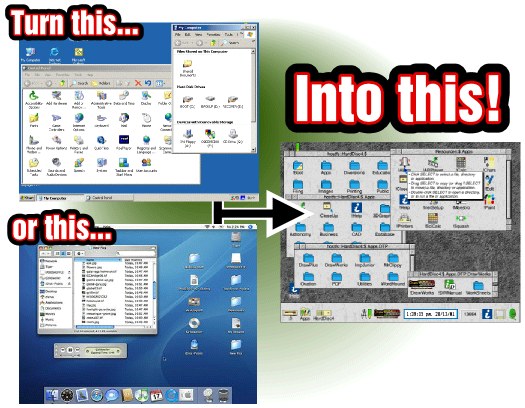 … in reality you you probably don’t want to do that!
… in reality you you probably don’t want to do that!
As of time of writing of this article there is a sale going on! You can buy VirtualRPC-SA for only about $100. My primary reason for getting it was porting aclock to RISC OS. In addition to the VM I also purchased the original compiler and developer tools (DDE). It allows to target the funky 26 bit CPU. Otherwise GCC is available for free.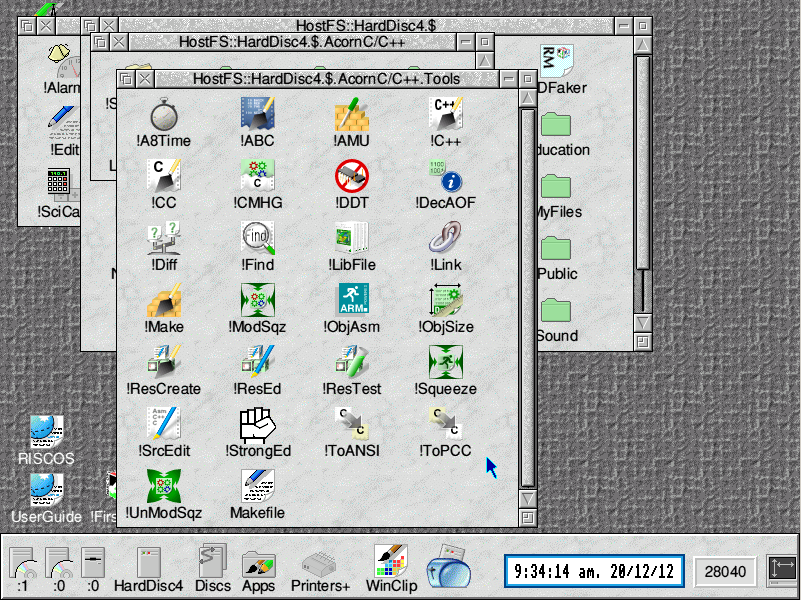 VirtualRPC comes “pre-installed” with the RISC OS in a virtual ROM image. The OS at first glance is quite nice looking and seems fun in to explore and play around. You can browse the web and use a bunch of weird applications from alien world. You can find a lot of software apps here and here and here. However I personally could not use this for anything more serious.
VirtualRPC comes “pre-installed” with the RISC OS in a virtual ROM image. The OS at first glance is quite nice looking and seems fun in to explore and play around. You can browse the web and use a bunch of weird applications from alien world. You can find a lot of software apps here and here and here. However I personally could not use this for anything more serious.
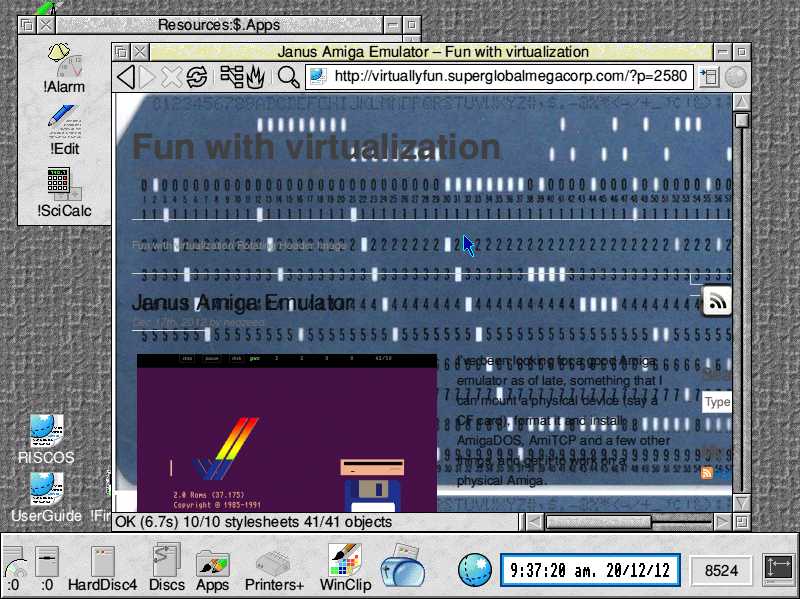 Porting of aclock to RISC OS was by far one of most difficult ones if not the most difficult. To display text on the screen you need to use system calls directly, for which you use a special function called _swi() or _swix(). There is no concept of sleep() so I had to improvise an empty loop. Fortunately there are screen codes that allow to position the cursor, clear screen etc.
Porting of aclock to RISC OS was by far one of most difficult ones if not the most difficult. To display text on the screen you need to use system calls directly, for which you use a special function called _swi() or _swix(). There is no concept of sleep() so I had to improvise an empty loop. Fortunately there are screen codes that allow to position the cursor, clear screen etc.
void cls(void) {
(void) _swix(OS_WriteI + 12, 0);
}
The result is far from pretty but it will do for v1:
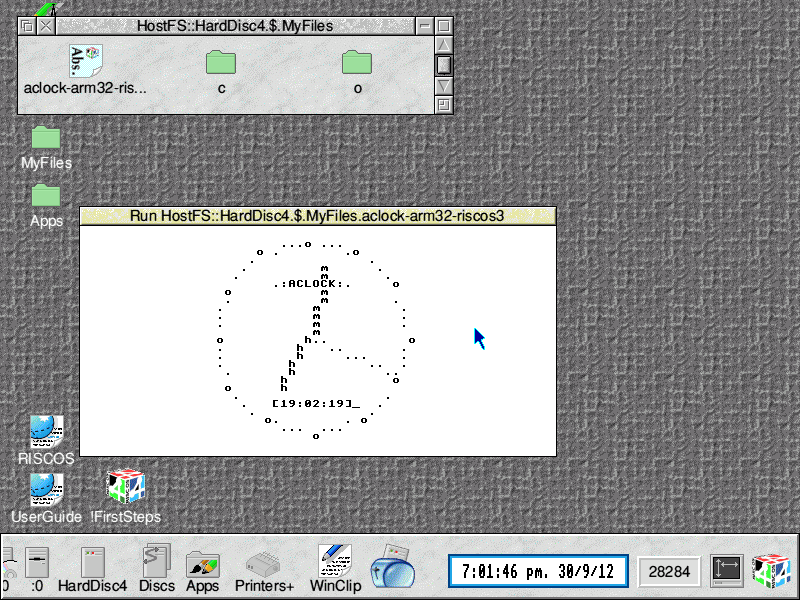 Some funnies, which actually weren’t that funny at the time:
Some funnies, which actually weren’t that funny at the time:
A directory separator in RISC OS is “.” (yes a dot) for example: root.folder.subfolder.file. The C compiler expects .c as a file extension as it would on any normal OS. The problem is that naming file aclock.c would make a directory aclock with c file in it. Fortunately, or maybe not, extensions in RISC OS are prefixing, not postfixing a file. So you have c.aclock or o.aclock. Except, as previously explained c and o are directories. You can see c and o folders in the screenshot above. Are you confused yet?
Interestingly RISC OS does have concept of a command line interface and a terminal window. However try to figure out the commands!
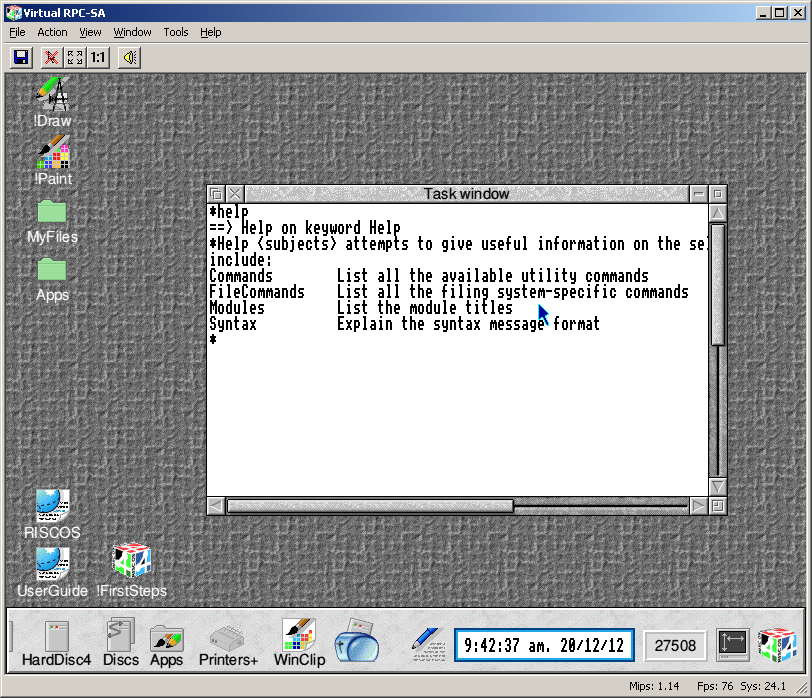 There is more, so I encourage you to try yourself just for the fun!
There is more, so I encourage you to try yourself just for the fun!